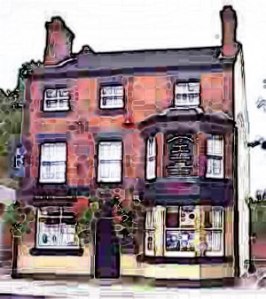Monk's Tower was designed by the Scottish country house architect William Burn, he was a pioneer of the Scottish Baronial style. The house was built before 1868 for F S J Foljambe, Liberal MP for Retford and Master of the Burton Hunt, at a cost of £6,000. He lived here for a short time while some alterations were being made at Osberton Hall in Nottinghamshire.
Foljambe relinquished his position of Mastership of the Burton Hunt and the house was auctioned, the following is a description of the house from the auction catalogue:
- GROUND FLOOR, Large Drawing-room, Dining-room (with a lift from the basement).
- FIRST FLOOR, Four spacious Bedrooms and Dressing rooms and two closets.
- SECOND FLOOR, Four bedrooms and one Dressing room.
- THE TOWER, Two Bedrooms and One Boxroom.
- The principal stairs are of stone, and there are also backstairs. Gas and Water are laid on and the house throughout is heated with hot water.
- In the BASEMENT is every requisite accommodation, including Kitchens, Pantry, Larder, two Storerooms, Servants' Hall, Still-room, Butler's room, Housekeeper's room, and above a portion of these, ample and very excellent accommodation for servants.
Trotter died in 1897 and Monk's Tower was offered for sale at auction, only reaching £`1,000 and was withdrawn from sale. The house was eventually sold in 1900 to Henry Elsey, a Lincoln corn merchant.
Henry Elsey was an owner of racehorses and had four stables built in 1901. Elsey moved to Eastcliffe House in about 1902.
The next tenant was Henry Charles Hynman Allanby, fomerly Major of the 3rd battalion Seaforth Highlanders. Allanby had two houses built for his gardener and his chauffeur in the grounds of the house in 1903 and a motor house (garage) in 1908.
Monk's Tower was offered for auction on 28th May 1920, unfortunately no bids were received. Lord Charles Bentinck was resident at Monk's Tower by 1921.
The house was empty for many years, and, like so many other grand houses, there were no buyers for the house and it was demolished in 1935. The stone was sent to the RAF Waddington and Scampton airfields for road building.
The Monk's Tower grounds were offered for sale by auction but was unsold, in August 1937 Lincoln Corporation bought the land for the building of initially 122 houses at what became Monk's Tower Estate (later just Tower Estate).


